While you are preparing for the fireworks and fun this Fourth of July, please take a few minutes to show your support for the legislation introduced in both the House and Senate chambers of Congress to award a Congressional Gold Medal to the U.S. Army Signal Corps telephone operators in World War I, known as "The Hello Girls."  As we celebrate Independence Day in 2023, there is no better time to join the effort to recognize America's first women soldiers with this award. Before you light that first sparkler, reach out to your Senators and Representatives, and tell them that you support this legislation which honors the brave American women who made tactical communications work for U.S. and French military forces on the front lines of World War I, but were denied veterans status and benefits after the war. Help to get this legislation passed through both Houses of Congress and onto the President's desk for signature this year. Yes, you can help! Click here for our toolbox that makes the process of reaching out to your Representative and Senators very straightforward. Please get in touch with your Senators and Representative, and tell them that you want them to support the Hello Girls Congressional Gold Medal legislation in the 118th Congress. The Hello Girls answered America's call in World War I -- please answer their call in 2023 and support this Congressional Gold Medal legislation! |
 National World War I Memorial Sculpture Update: One More Section To GoSculptor Sabin Howard took to Instagram June 15 to report on the challenges encountered preparing to ship the next-to-last segment of the monumental sculpture for the National World War I Memorial in Washington, DC to the Pangolin Foundry in the UK. Howard is now working on the final section of what will be, when installed in 2024, the largest free-standing high-relief bronze in the Western Hemisphere. Click here or on the image above to view more photos of the shipping process on Sabin’s Instagram channel.  Fox News 5 in New York, NY recently broadcast a follow-up report looking at the progress at Sabin Howard studios on “A Soldier’s Journey,” in which Howard says that the creation has been "a labor of love" for him. .FOX 5 first interviewed Howard in 2015. Click here or on the image above to read the interview and watch the video. Army Renames Louisiana Base For Black WWI Hero Who Received Medal Of Honor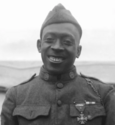 A U.S. Army base in western Louisiana has been renamed to honor Sgt. William Henry Johnson, a Black hero of World War I who received the Medal of Honor nearly a century later. “Sgt. William Henry Johnson embodied the warrior spirit, and we are deeply honored to bear his name,” Brig. Gen. David Garner, the commanding general of the Joint Readiness Training Center at Fort Johnson, said in a post on Twitter. While serving on the front lines of France in 1918, Johnson fought off a German night raid near the Argonne Forest, according to the National Museum of the United States Army. Johnson was wounded 21 times while beating back the attacking forces. He also prevented a wounded Black comrade from being taken prisoner when, after running out of grenades and ammunition, he killed two German soldiers with his knife. Click here to read more about Sgt. Johnson's valorous service in WWI, and why he was selected for this signal honor by the U.S. Army |
During the week of June 18, 2023, Daily Taps at the National World War I Memorial in Washington, DC was sounded in honor of WWI veteran Hoddie Wilbur Daniels, M.D.. American Legion H.S. Daniels Post Number 29 was named for Captain Daniels, a native of Randolph County, WV, and a practicing physician in Elkins for over 20 years prior to his volunteering in the Medical Corps. U.S. Army in 1917. He went to France with the 38th Infantry, 3rd division in April 1918. In the Aisne-Marne offensive on July 19,1918, he learned about 40 wounded Americans who were held captive back of the German lines. Calling for volunteers, he and about eight or ten men crawled to a point near the prisoners. He stood up and demanded their release to him for treatment. The guards immediately fired on him, but they in turn were fired upon by the Americans. Several were killed and the others surrendered. The American wounded and German prisoners were returned to the American lines, where it was found that one or two had not made it. Captain Daniels returned to "No Man's Land" in search of the missing, and there was killed by a German sniper. | | 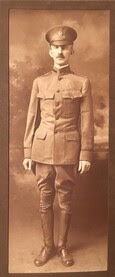 |
The Daily Taps program of the Doughboy Foundation provides a unique opportunity to dedicate a livestreamed sounding of Taps in honor of a special person of your choice while supporting the important work of the Doughboy Foundation. Choose a day, or even establish this honor in perpetuity. Click here for more information on how to honor a loved veteran with the sounding of Taps. 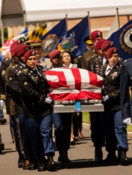 After 105 years, on 7 June 2023, the remains of an Unknown American Doughboy were given a dignified and honored burial about 70 miles northeast of Paris, in the Oise-Aisne American Cemetery where 6,012 of his comrades – 597 unknowns – already rest. With this, the American Battle Monuments Commission interred its first Great War unknown in 35 years. The ceremony also marked the first burial of an unknown U.S. soldier at this cemetery since 1932. Author Attila Szalay-Berzeviczy traveled to France "just for this ceremony, in order to document it with my camera." Click here to read more about the ceremony, and what new project will be publishing his amazing photos. |
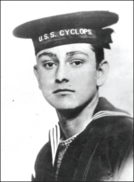 Early in 1918, the collier U.S.S. CYCLOPS was tasked to transport a cargo of manganese ore from Rio de Janeiro, Brazil to Baltimore, Maryland. After departing an overnight layover at Barbados on March 4, 1918, the CYCLOPS was never sighted again. Lost with her was Seaman Earnest Randolph Crammer from Asbury Park, NJ (left),along with the 308 other persons who were aboard. Marvin Barrash, author of three books about CYCLOPS, takes a look at several of the crew members "who served on board the U.S.S. CYCLOPS, from all walks of life." Click here to read the entire article, and watch the accompanying video. |
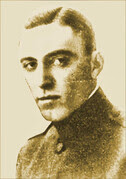 With America’s entry into the First World War, George Hormel, founder of meat packing firm Hormel & Company hoped that his son Jay might be deferred from military service, but the young man was eager to serve. And serve he did: commissioned a 2nd Lieutenant of infantry, assigned to the 301st Ice Plant Company under the Services of Supply, Jay put the experience he had gained from the family meat packing business to good use. His innovations made a huge impact on the food supply of the American Expeditionary Forces, ensuring that the Doughboys were well-fed. His military service ended in December 1918, but his interest in his fellow servicemen did not. Click here to read more, and learn how his WWI experience helped Hormel develop a certain famous meat product that fed the G.I.s in WWII, and Americans ever after. |
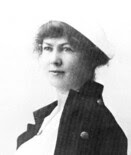 Nurse Anna Marie McMullen of Allentown Hospital in Pennsylvania answered her country’s call in April 1918, shipping off to France along with thousands of other nurses from the U.S. to care for wounded soldiers. Six months later, suffering from pneumonia, she drew her last breath at an American Expeditionary Forces hospital in Mesves-sur-Loire in central France. It was Oct. 6, 1918. She was 30. On the Lehigh Valley Health Network web site, Joe Nixon looks back at how McMullen "gave early and continually growing promise of distinction in her chosen profession, a promise which failed of fulfillment because of her early and lamented death.” Click here to read the entire story of "the brave young woman who had made the great sacrifice in the war." |
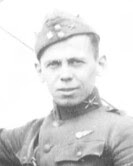 A man is only missing if he is forgotten. Our Doughboy MIA this month is Captain Kenyon Roper. Early in the morning of Saturday, 14 September 1918, First Lieutenant Paul H. “Huggy” Hughey entered the office of his Squadron Commander, Captain Everett R Cook, with a request. The pilot, Lieutenant Hughey, was due to take off soon on a reconnaissance mission behind enemy lines with Captain Kenyon Roper as his Observer and Gunner. Lieutenant Hughey asked to be replaced on this mission because he feared Captain Roper, who was just over five feet tall, was too small to handle the twin ring mounted Vickers 303 machineguns properly on their Salmson 2-A-2 aircraft. Captain Cook, understanding his concern, offered to fly the mission with Captain Roper in Lieutenant Hughey’s place. Hughey refused as he felt that Captain Cook was flying more than his share of missions. Hughey and Roper departed the aerodrome at Gondreville, Meurthe et Moselle sometime between 7:20 and 7:30 in the morning. Flying in their trusted Salmson, number 7, they were never seen again. Kenyon Roper, from Steubenville, Ohio was born on 31 March 1895, He was the second son of George A. Roper Sr., an undergarment manufacture and Jean Kinsey Roper. On national draft day, 5 June 1917, Kenyon Roper was a registered student attending the Massachusetts Institute of Technology (MIT). In fact, both sons were MIT students in June 1917 and registered for the draft at the same time. Both would leave MIT to fly in the war. George A. Roper Jr., or “Hemp” as he was called, couldn’t get in the American Air Service so he joined the Royal Air Force to be a pilot. Kenyon would join the Costal Artillery Corps, training at Fortress Monroe in Virginia. He would receive his commission as a second lieutenant on 9 August 1917 and departed New York harbor for Europe on 12 December 1917 aboard the S.S. Manchuria. Upon arrival in France Lieutenant Kenyon Roper would learn he had been promoted to First Lieutenant with the same date of rank as his Second Lieutenant’s commission, 9 August 1918. While training with France’s 7th Army, Kenyon Roper would receive a temporary commission to Captain on 7 March 1918 attesting to his intelligence and ability. He would subsequently volunteer to train as an Observer in the Air Service and after graduating from Observer school he would fly Army Corps missions with France’s Escadrille 221 in Breguet XIVs to gain combat experience. Then on 1 June 1918 he and two other Observers were assigned to the 91st Aero Squadron on 1 June 1918. Unfortunately, one week prior to his assignment to a combat squadron, on 25 May 1918, his brother Second Lieutenant George A. Roper Jr., would die in a flying accident. Piloting a British Airco DH9, “Hemp” Roper was extremely low to the ground when he banked and simultaneously hit by a strong wind. The aircraft flipped over and spun into the ground, bursting into flames. George “Hemp” Roper Jr. died before he had a chance to fight in the war. Kenyon Roper would visit his grave before he began flying combat missions. Would you like to be involved with solving the case of Captain Kenyon Roper, and all the other Americans still in MIA status from WWI? You can! Click here to make a tax-deductible donation to our non-profit organization today, and help us bring them home! Doughboy MIA will be mounting another mission to France this summer. Help us do the best job possible and give today, with our thanks. |
Merchandise from the Official
Doughboy Foundation WWI Store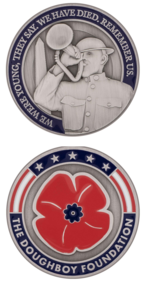 | | A great keepsake to commemorate
Daily Taps at the National World War
One Memorial in Washington, DC. - A Doughboy.shop Exclusive Commemorative Coin
- The double-sided design showcases the iconic Doughboy Bugler / Poppy design
- Soft enamel color detailing
- Measures 1 3/4″
- Bronze alloy w/ nickel-silver finish
|
Proceeds from the sale of these items will help build the new National World War I Memorial in Washington, DC. This and many other items are available as Official Merchandise of the Doughboy Foundation. |


